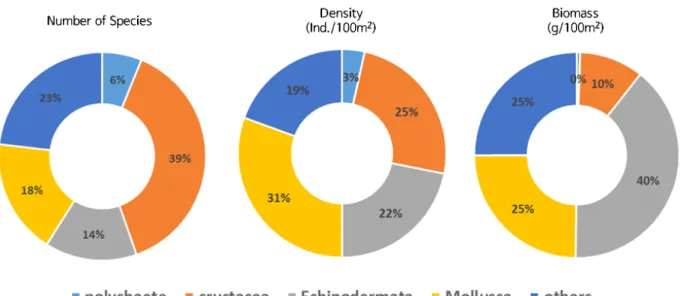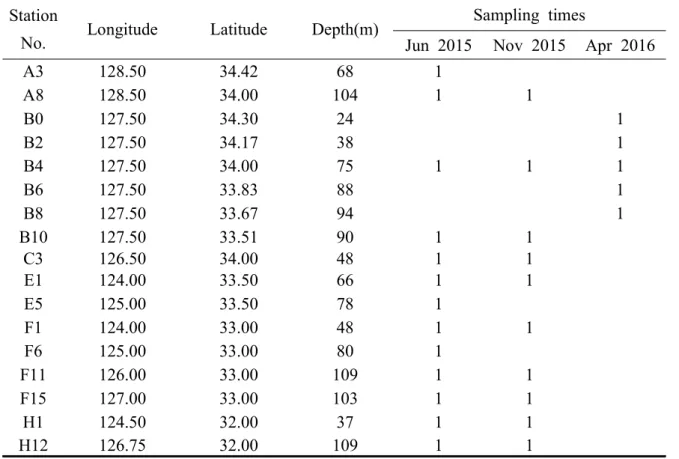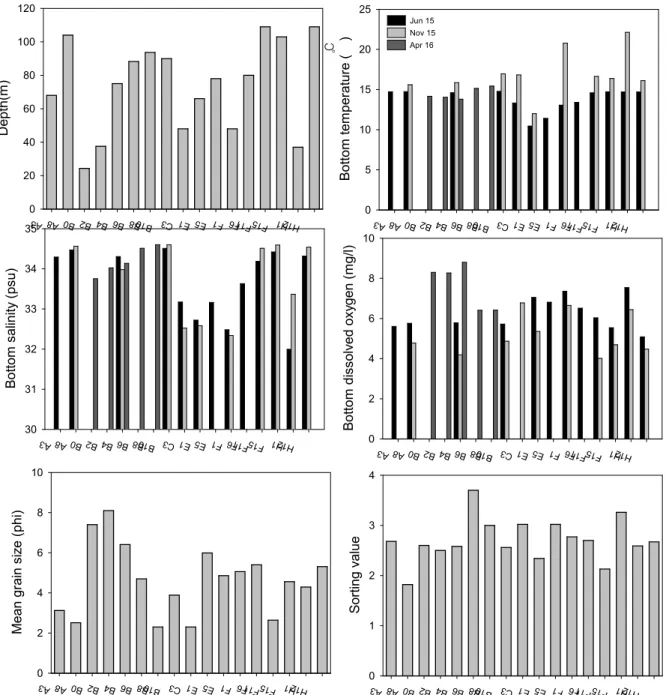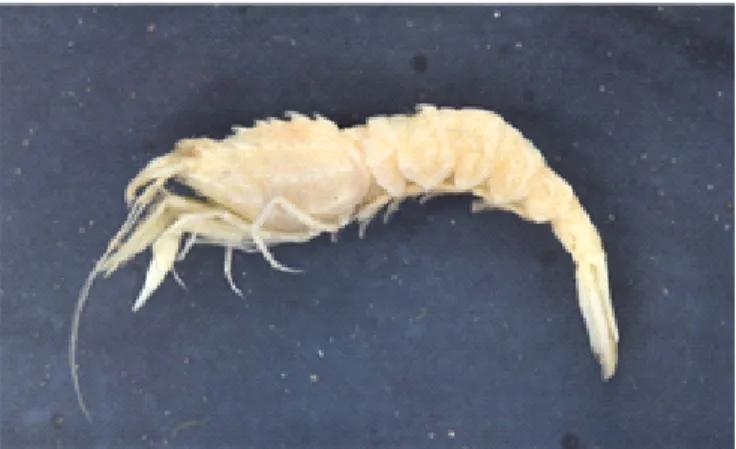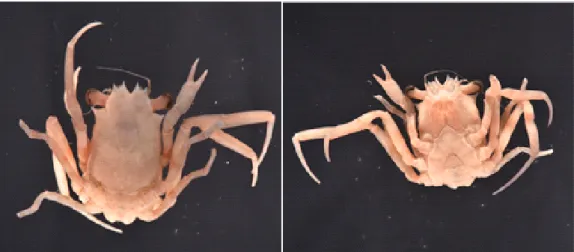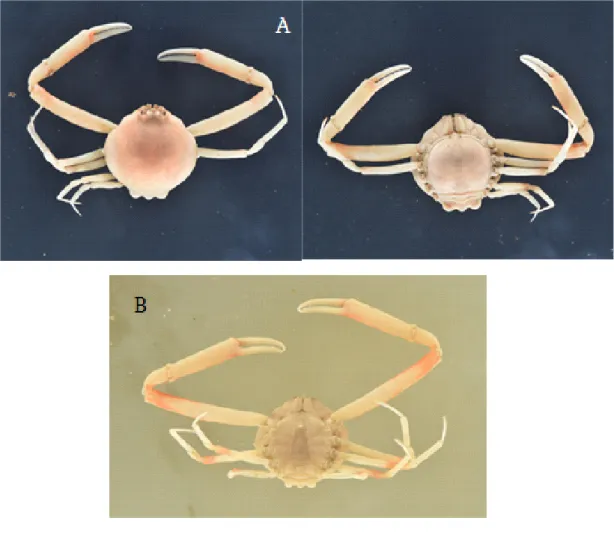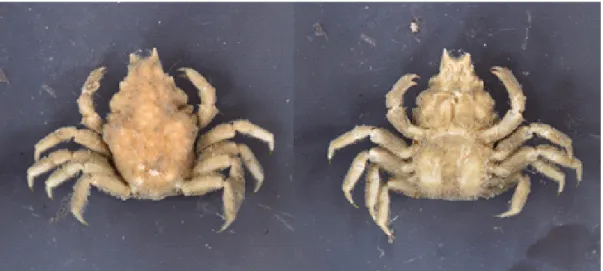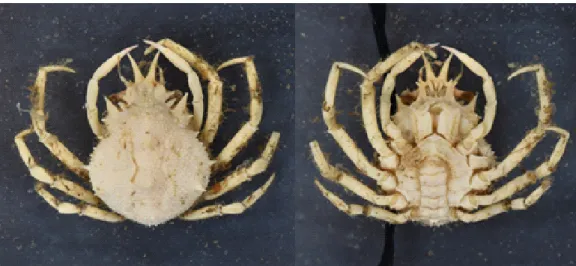Study of the distribution and species composition of the Megabenthos in the South Sea of Korea. 17 Dendogram and 2-dimensional plot using megabenthic fauna abundance data by Bray-Curtis similarity calculated on the fourth root. 18 Dendogram and 2-dimensional plot using megabenthic fauna abundance data by Bray-Curtis similarity calculated on the fourth-root transformed abundance data in the South Sea of Korea in April Fig.
21 Dendogram and two-dimensional plot using megabenthic fauna abundance data by Bray-Curtis similarities calculated from the fourth root-transformed abundance data in the South Sea of Korea ··· 51. The South Sea of Korea is influenced by three current systems: the Jeju Warm Current with high temperature and high salinity; the low-salinity drainage of the Yangtze River from China; and the cold-water bottom currents of the Yellow Sea. Therefore, in this study we analyzed the diversity and distribution of the South Sea megabenthos based on environmental factors.
Megabenthos
Previous studies on megabenthos have been conducted mostly in the deep sea using deep-sea cameras and ROVs. 2001) concluded that megabenthos play an important role in abyssal ecosystems, as they constitute the major part of the deep-sea benthic biomass. Amon et al (2016) reported that megafauna showed a positive correlation with nodule abundance on the abyssal seafloor of the Clarion-Clipperton Zone.
Several studies have reported that megabenthos density and distribution are related to depth (Hecker, 1990; Jones, 2007; Linse, 2013). The distribution of the megabenthic faunal community is related to topography, substrate, sediment conditions and food sources (Hecker, 1990; Jones, 2007; Ramirez-Llodra et al., 2010; Yu et al., 2014). Consequently, studying the structure of the megabenthos community in relation to the environmental variables of the study area can facilitate the understanding of their biodiversity and distribution.
Information of study area
In addition, the East China Sea is an important area for understanding the subtropical ecosystem's impact on global warming (Yu et al., 2008; MLTL, 2010). Under the influence of the subtropical current, tropical or subtropical megafaunal species are expected to appear in the South Seas of Korea. Our specific goals are to (1) identify species of megabenthos, (2) analyze the distribution and community structure of megabenthos, and (3) find out the significant environmental variables on the distribution and species composition of megabenthos.
There were no significant differences in salinity, but the Southern Ocean frontal zone had higher salinity than other stations. A cluster analysis and MDS analysis of the Bray-Curtis similarity matrix based on the density of megabenthos in November 2015 divided the study area into two groups according to species contribution. Group a was located east of Jeju Island, and group b consisted of the stations west of Jeju Island with B4 in the Southern Ocean Frontal Zone (Fig. 17).
A cluster analysis and MDS analysis of the Bray-Curtis similarity matrix based on the density of the megabenthos in November 2015 divided the study area into two groups according to species contributions (Fig. 18). A cluster analysis and MDS analysis of the Bray-Curtis similarity matrix based on the density of the megabenthos in study period divided the study area into seven groups according to species contributions (Fig. 21). In this study on the megabenthos of the South Sea, 6 crustacean crabs were recorded for the first time.
As a result, the distribution of the dominant species that are mainly epibenthic species is related to the composition of the sediments. New production and F ratio on the continental shelf of the East China Sea: Comparisons between nitrate inputs from the subsurface Kuroshio. Macro- and megabenthic fauna on the continental shelf of the eastern Amundsen Sea, Antarctica.
Study of the variations in sea environment and marine ecosystem in the South Sea (northern East China Sea) due to the climate change. The study of the oceanographic environmental impact in the South Sea (East China Sea) due to the Three Gorges Dam. Patterns and determinants of the distribution and structure of benthic faunal assemblages in the northern North Atlantic.
Megabenthic diversity patterns and community structure of the Blanes submarine canyon and adjacent slope in the northwestern Mediterranean: human encroachment. Diurnal and tidal changes in the abundance of macro- and megabenthic communities in the Jangbong Tidal Flat, Incheon, Korea.
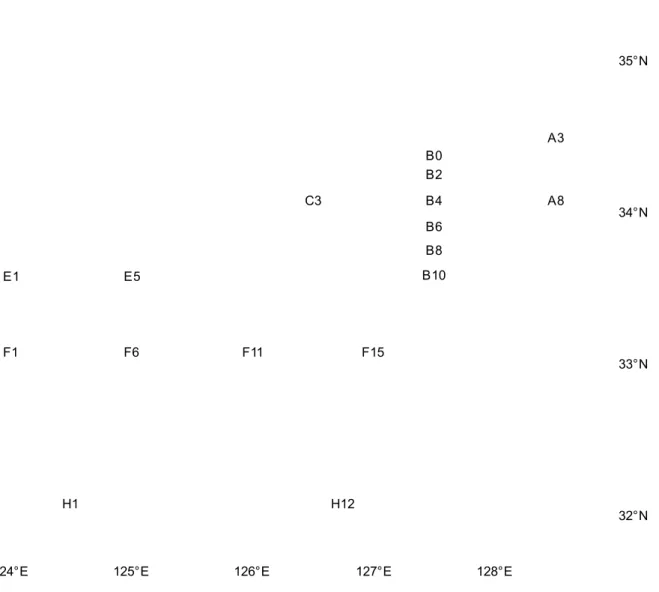
Aims of this study
Environment analysis
Environmental factors such as temperature, salinity, and dissolved oxygen (DO) were measured with a CTD instrument at each sampling site, and surface sediment samples were collected in a 50 mL conical tube for sediment grain size analysis. Sediment samples were classified into coarse-grained sediments and fine-grained sediments after removal of organic matter and CaCO3. Sediment samples were dried for 48 h at 50 ℃ before 1 g of samples were treated with 10% hydrogen peroxide to decarbonize with 0.1 N hydrochloric acid and heated to over 100 ℃ to evaporate the hydrogen peroxide, and then washed 3 times with distilled water to remove organic matter and salts.
Sediment grain size composition was determined using a dry sieving method with a Ro-Tap sieve shaker (< 4 phi; W.S. Tyler) coupled with a laser.
Making images
Data analysis
Result
Diversity of megabenthos
Pareurystheus latipes Tzvetkova, 1977 Protomedeia crudoliops Hirayama, 1984. Alpheus brevicristatus De Haan, 1844 도미 Alpheus japonicus Miers, 1879 Langfodet 도미 Betaeus granulipper Shimpr Yokoya, 1927. Crangon affinis De Haan, 1849 보라색 새우 Crangon ha Kodatei Rathbun, 1902년 Tørrede Purple Rejer.
Metacrangon sinensis Fujino & Miyake, 1970 Paracrangon abei Kubo, 1937 가시새우. Areopaguristes japonicus (Miyake, 1961) Dardanus arrosor (Herbst, 1796) 왼손 발톱에 가는선이 있습니다. Diogenes edwardsii (De Haan, 1849) Paguristes digitalis Stimpson, 1858 Paguristes ortmanni Miyake, 1961 Paguristes digitalis Stimpson, 1961.
Lophopagurus (Australeremus) triserratus (Ortmann, 1892) Pagurus brachiomastus (Thallwiz, 1891) Harige knyter. Palaemon gravieri (Yu, 1930) Palaemon ortmanni Rathbun, 1902 Langbeengarnale. Metapenaeopsis dalei (Rathbun, 1902) Parapenaeopsis hardwickii (Miers, 1878) Trachysalambria curvirostris (Stimpson, 1860) Blomgarnale.
Hadropenaeus lucasii (Bate, 1888) Charybdis riversandersoni Mala kozica. Ctenoides annulatus (Lamarck, 1819) Lima fujitai Oyama, 1943 Samtaegi pokroča. Cryptopecten vesiculosus (Dunker, 1877) Laevichlamys cuneata (Reeve, 1853) Scaeochlamys squamata (Gmelin, 1791) Red pokrovač Venerida.
Astropecten kagoshimensis de Loriol, 1899 가고시마 불가사리 Astropecten polyacanthus Müller & Troschel, 1842 가시 불가사리 Ctenopleura fisheri Hayashi, 1957 Fishel's side 불가사리. Astrocladus coniferus (Döderlein, 1902) Astroboa arctos Matsumoto, 1915 거미불가사리. Ophiothrix (Ophiothrix) Koreana Duncan, 1879 가족 뱀주인과.
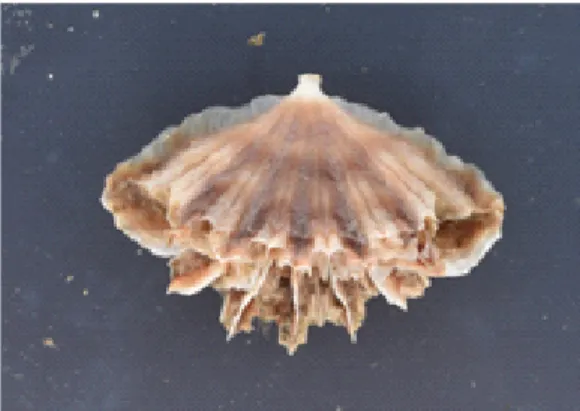
Distribution and species composition of megabenthos
- Species composition
- Dominant species
- Community structure
A cluster analysis and MDS analysis of the Bray-Curtis similarity matrix based on the density of megabenthos in June 2015 divided the study area into three groups according to the contribution of species: Group a was located east of Jeju Island, group b consisting of south Sea Station and south of Jeju Island, Group c located diagonally from the south coast to the region southwest of Jeju Island (SIMPROF test, P < 0.05) (Fig. 16). 16 Dendogram and 2-dimensional plot using megabenthic fauna abundance data of Bray-Curtis similarities calculated on fourth-root transformed abundance data i. 17 Dendogram and 2-dimensional plot using megabenthic fauna abundance data of Bray-Curtis similarities calculated on fourth-root transformed abundance data i.
18 Dendogram and 2-dimensional plot using megabenthic fauna abundance data by Bray-Curtis similarity calculated on the fourth-root transformed abundance data in the. 21 Dendogram and 2-dimensional plot using megabenthic fauna abundance data by Bray-Curtis similarity calculated on the fourth-root transformed abundance data in the. The BIO-ENV analyzes of the megabenthos and environmental variables revealed that depth, gravel content and sorting value (ø) showed the highest correlations with megabenthic community (Rho = 0.353, P < 0.01) (Table 9).
In June and November 2015 and April 2016, sampling was conducted at 17 stations in the South Sea, Jeju Island region and Ieodo Coast of Korea to identify the impact of environmental variables on the diversity and distribution of megabenthos in the South Sea of Korea. These patterns may be caused by the summer cold-weather bottom currents of the Yellow Sea (KIOST, 2018). On the other hand, bottom temperature at HI in November 2015 was considered relatively high, which may be the influence of the high-temperature Kuroshio Current traveling northward.
In this study, the reduced density of megabenthos in deep water may therefore be related to organic conditions in the sediments. Others) and the gastropod Siphonalia fuscolineata (MGs) were shown at most stations except in the southern sea of Jeju Island (Fig. 15. However, the low density and biomass was at station H12 in the southernmost part of Jeju Island).
Rhoads et al. (1985) reported that density decreases with increasing silt and clay content from the central East China Sea to southern Jeju Island, which is associated with resuspension of Yellow Sea sediments. Macrobenthic species diversity usually increases with fine grain size (McLachlan, 1990), but sometimes the number of species increases relatively with coarse sediment grain size (Lim and Choi, 2001; Yu et al., 2013; Jung et al. ., 2014). . Distribution patterns of the sand-bottom macrobenthic community in the Hupo coastal area of the East Korea Sea.
